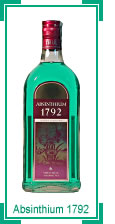Absinthe Time
Kremencova 5, Prague 1
Phone: +420 222 516 300
Every thursday from 20:00 they have live jazz…and here is their absinthe menu:
Absinthe STAROPLZENECKY (70% alc., Thujon 10 mg/l.)
Absinthe RED L’Or (70% alc., Thujon 10 mg/l)
Absinthium 1792 GREEN (70% alc., Thujon 10 mg/l)
Absinthium 1792 RED (70% alc., Thujon 10 mg/l)
Absinthe Bitter Bairnsfather, SEBOR (55% alc., Thujon 32 mg/l)
Absinthe Bitter Extra Anise, SEBOR (55% alc., Thujon 32 mg/l)
Absinthe HILLS (70% alc., Thujon 4 mg/l)
Absinthe Le Fee Hypno (70% alc., Thujon 10 mg/l)
Absinthe REALITY, SEBOR (60% alc., Thujon 26 mg/l)
Absinthe FRUKO (60% alc., Thujon 10 mg/l)
Absinthe FRUKO (70% alc., Thujon 10 mg/l)
Absinthe STAROREZNA DEVIL(red) (70% alc., Thujon 10 mg/l)
Absinthe STAROREZNA (70% alc., Thujon 10 mg/l)
Absinthe ZELENA MUZA (72% alc., Thujon 10 mg/l)
Absinthe ZELENA MUZA ART (72% alc., Thujon 10 mg/l)
Absinthe 35 (70% alc., Thujon 35 mg/l)
Absinthe KING OF SPIRITS (70% alc., Thujon 10 mg/l)
Absinthe La Boheme Original (70% alc., Thujon 10 mg/l)
Absinthe La Boheme Bitter Spirit (60% alc., Thujon 35 mg/l)







 Masopust is the February festival in the Czech Republic that most resembles Mardi Gras. This is a time of drinking: loads of roast pork (cooked on open spits), washed down with cold beer (“pivo”) and plenty of other drinks like absinthe.
Masopust is the February festival in the Czech Republic that most resembles Mardi Gras. This is a time of drinking: loads of roast pork (cooked on open spits), washed down with cold beer (“pivo”) and plenty of other drinks like absinthe.













